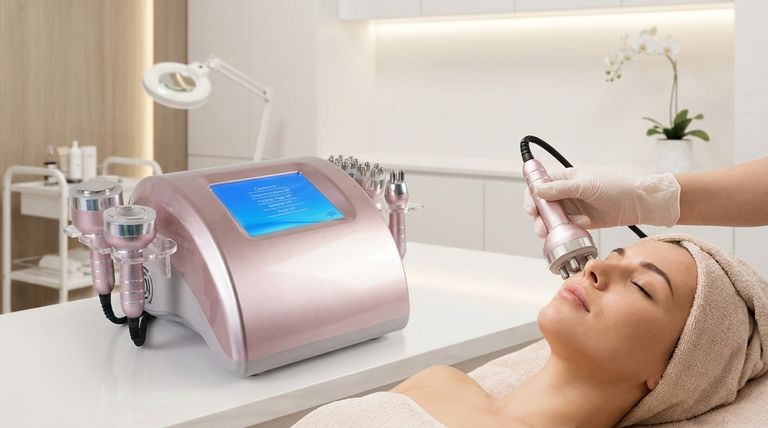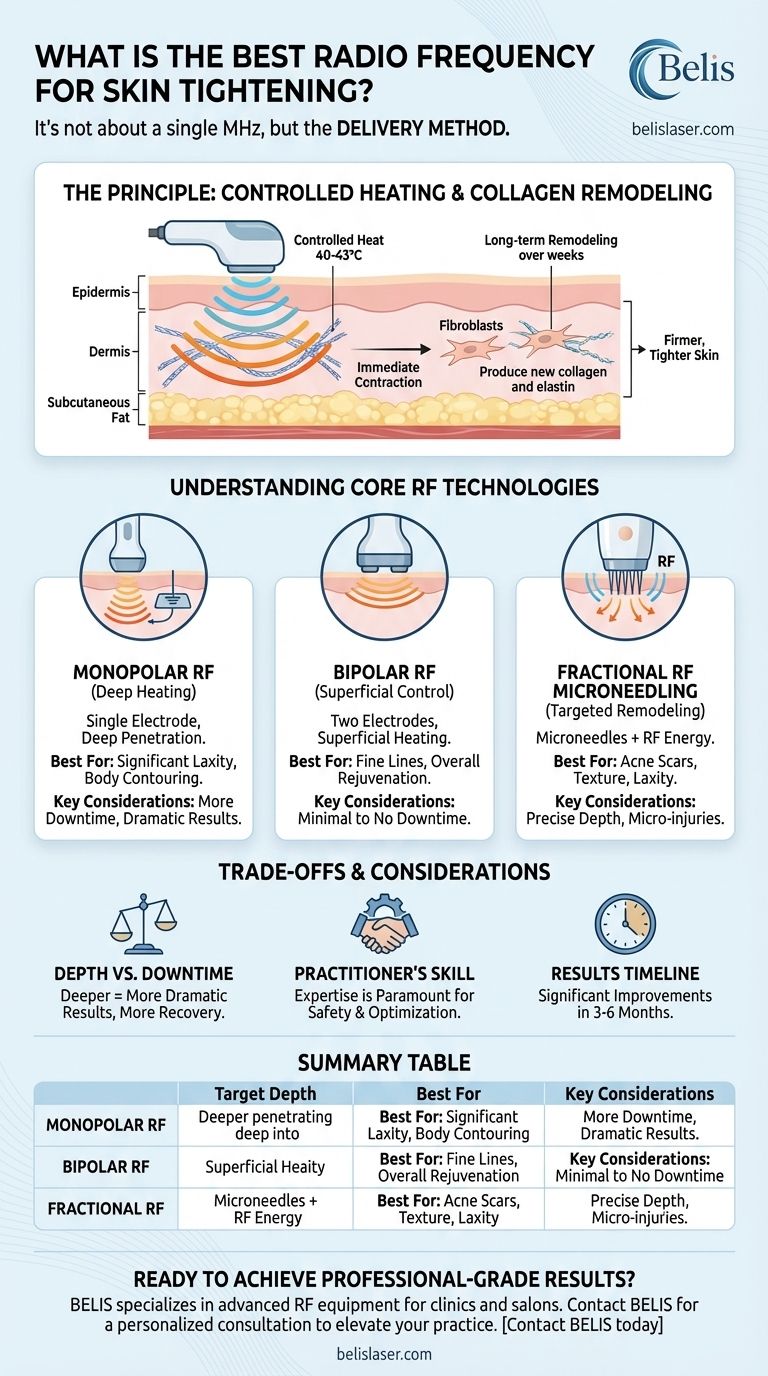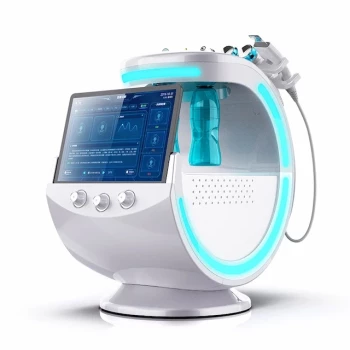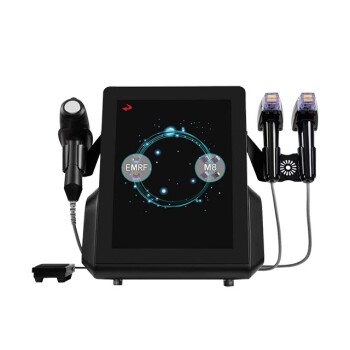When selecting a radiofrequency treatment for skin tightening, the conversation isn't about a single "best" frequency in megahertz (MHz). Instead, the crucial factor is the method by which the RF energy is delivered into the skin. Different technologies, such as monopolar, bipolar, and fractional RF, are designed to target different depths and address distinct concerns, from surface texture to deep tissue laxity.
The effectiveness of a radiofrequency treatment is determined not by a specific frequency number, but by its ability to deliver a controlled amount of heat to the precise depth of skin required to stimulate collagen production for your specific goal.

How Radiofrequency Actually Tightens Skin
To choose the right treatment, it's essential to first understand the fundamental principle at work. Radiofrequency devices are not all the same, but they operate on a shared biological mechanism.
The Principle of Controlled Heating
Radiofrequency technology uses a safe electrical current to create thermal energy, or heat, within the deeper layers of the skin, such as the dermis.
This process is highly controlled, heating the targeted tissue to a specific temperature (typically between 40-43°C) without damaging the outer layer of the skin (the epidermis).
The Collagen Remodeling Response
This targeted heat triggers a two-part response from your body. First, it causes the existing collagen fibers to contract, providing an immediate, albeit subtle, tightening effect.
More importantly, this thermal stress signals the body to begin a natural healing process. This stimulates fibroblasts—the cells responsible for creating connective tissue—to produce new, stronger collagen and elastin over the following weeks and months. This long-term collagen remodeling is what produces significant and lasting skin tightening and improvement in texture.
Understanding the Core RF Technologies
The brand names you encounter (like Morpheus8, FaceTite, or Exilis) are commercial applications of a few core underlying technologies. Understanding these categories is the key to making an informed decision.
Monopolar RF (Deep Heating)
In a monopolar system, the energy flows from a single electrode on the handpiece through the body to a grounding pad.
This configuration allows the RF energy to penetrate deeply into the tissue, reaching the dermis and even the subcutaneous fat layers. It is best suited for addressing significant skin laxity and for body contouring.
Bipolar RF (Superficial Control)
Bipolar devices confine the RF energy between two electrodes located on the treatment handpiece itself.
Because the energy path is much shorter and more controlled, this method heats the tissue more superficially. It is an excellent choice for targeting fine lines, wrinkles, and improving skin quality in the upper layers of the dermis with minimal downtime. Forma is a well-known example of this technology.
Fractional RF Microneedling (Targeted Remodeling)
This advanced approach combines two treatments: microneedling and radiofrequency. Ultra-fine needles penetrate the skin to a precise, controlled depth and then deliver a pulse of RF energy.
This method creates micro-injuries that stimulate healing while the RF energy heats the tissue from the inside out. It is exceptionally effective for treating not only skin laxity but also textural issues like acne scars, enlarged pores, and wrinkles. Morpheus8 and Fractora are leading examples in this category.
Understanding the Trade-offs
No single technology is universally superior; each comes with its own set of considerations. Choosing wisely involves balancing effectiveness with your tolerance for discomfort and downtime.
Depth vs. Downtime
Deeper treatments, like aggressive RF microneedling, generally produce more dramatic tightening results. However, they are also associated with more post-treatment redness, swelling, and a longer recovery period.
Superficial treatments, like bipolar RF, are much gentler and often have no downtime, but they typically require more sessions to achieve visible results and are best for mild concerns.
The Practitioner's Skill is Paramount
The brand of the machine is secondary to the expertise of the person operating it. A skilled practitioner can accurately assess your skin's needs and customize the treatment's depth and energy levels for optimal results and safety.
An inexperienced operator can deliver a suboptimal or even unsafe treatment, regardless of how advanced the device is.
Results Are Not Instantaneous
While you may see some initial firming from collagen contraction, the true, lasting results of RF treatments depend on new collagen growth. This biological process takes time.
You can expect to see the most significant improvements emerge between three to six months after your final treatment session.
Making the Right Choice for Your Goal
Your decision should be guided by your primary concern. Consult with a qualified provider to determine which technology platform is best suited to help you achieve your desired outcome.
- If your primary focus is significant skin laxity and jawline contouring: You will likely benefit from technologies that deliver heat deeper into the tissue, such as monopolar RF or deep fractional RF microneedling.
- If your primary focus is fine lines and overall skin rejuvenation: A less invasive bipolar RF treatment or a course of superficial RF microneedling is often the most effective approach.
- If your primary focus is treating acne scars and improving skin texture: Fractional RF microneedling is the definitive choice, as it directly targets textural irregularities while also promoting skin tightening.
Ultimately, the most effective treatment is one that is precisely matched to your unique anatomy and aesthetic goals by a skilled professional.
Summary Table:
| RF Technology | Target Depth | Best For | Key Considerations |
|---|---|---|---|
| Monopolar RF | Deep tissue | Significant skin laxity, body contouring | More downtime, dramatic results |
| Bipolar RF | Superficial dermis | Fine lines, overall skin rejuvenation | Minimal to no downtime |
| Fractional RF Microneedling | Precise, controlled depth | Acne scars, texture, laxity | Combines collagen stimulation with micro-injuries |
Ready to achieve professional-grade skin tightening results?
BELIS specializes in providing medical aesthetics clinics and premium beauty salons with the most advanced and effective radiofrequency equipment. Our expert team will help you select the perfect technology—whether it's deep-penetrating monopolar, precise fractional RF microneedling, or gentle bipolar systems—to meet your clients' specific needs and grow your business.
Contact BELIS today for a personalized consultation and discover how our professional medical aesthetic equipment can elevate your treatment outcomes and practice reputation.
Visual Guide

Related Products
- Ultrasonic Cavitation Radiofrecuency Machine for Body Slimming
- Hydrofacial Machine with Facial Skin Analyzer and Skin Tester
- 4D 12D HIFU Machine Device for Skin Tightening
- 12D HIFU Machine Device for Facial HIFU Treatment
- 7D 12D 4D HIFU Machine Device
People Also Ask
- Do fat cavitation machines really work? A Professional's Guide to Body Sculpting
- When should you not use a cavitation machine? Critical Safety Guidelines for Aesthetic Treatments
- What are the restrictions for cavitation? Ensure Your Safety and Treatment Success
- Where does fat go after cavitation? Understand the Journey from Cell to Elimination
- Does cavitation destroy fat cells permanently? Yes, for targeted, stubborn fat reduction.



















